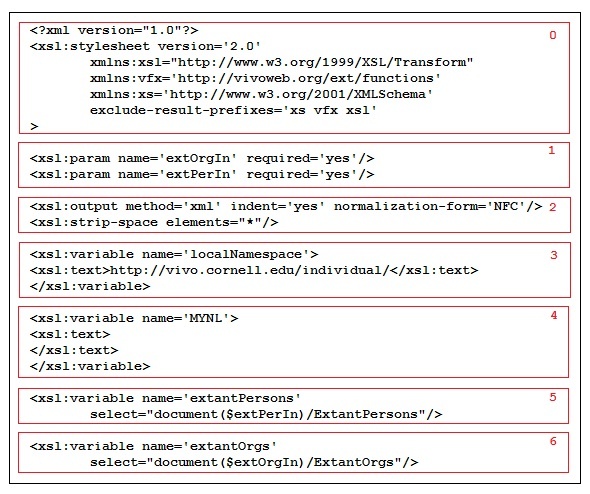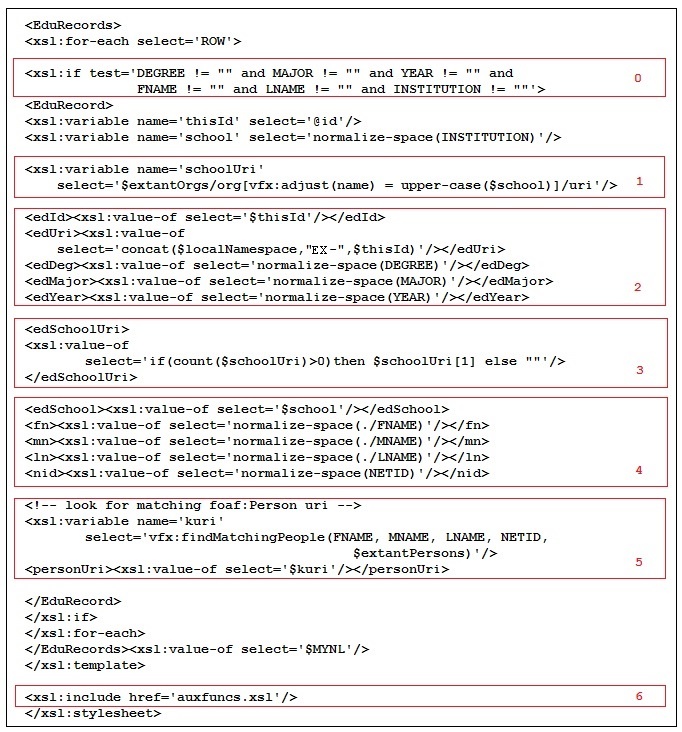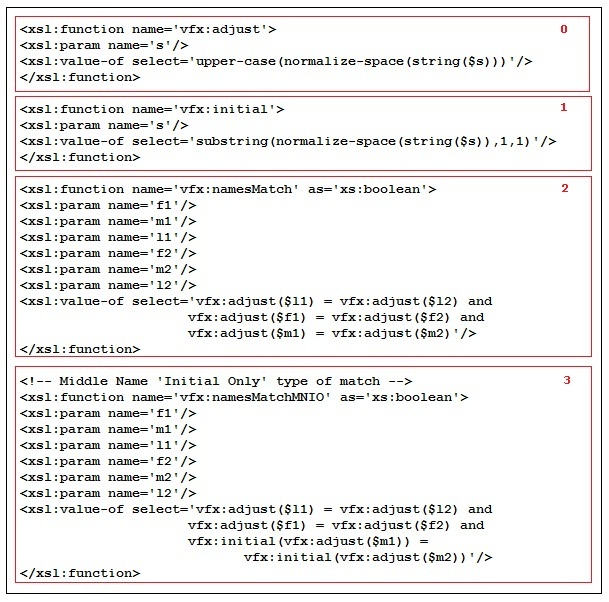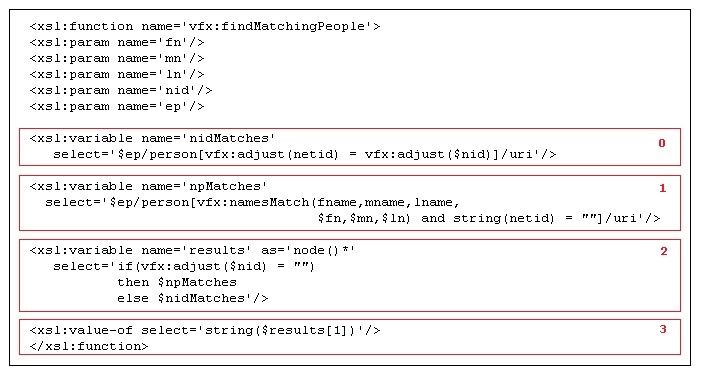Gather
This step is performed by the gather.xsl transform which can be found in its entirety the example/xslt folder. Figure 5 shows the first portion of this XSLT. We will now comment on the highlighted sections. In what follows, we will use [FnHm] to denote Figure n, Highlight m.
gather.xsl Fragment 1 - Figure 5
- [F5H0] This is the usual XSLT boiler plate where namespaces and short hand prefixes are declared. In this example, the vfx prefix will be used to identify functions that were created to support the ingest process.
- [F5H1] Two required parameters that are file system paths that point to the accumulator files.
- [F5H2] The usual output declaration including normalization of character sets.
- [F5H3] A variable is declared here to define the namespace we use for individual URIs at Cornell. This will be used as a prefix for new URI local names. You should change this variable in gather.xsl to reflect your VIVO instance.
- [F5H4] A variable used to append a newline character to the output where needed. This is mainly for adjusting output for readability.
- [F5H5-6] Two variable declarations that provide a means to access the pre-existing people and organization data from Per0.xml and Org0.xml.
Next we consider the highlights of the second half of the gather.xsl file. This part of the code handles filtering of the source, construction of the output xml and resolving as many URIs as possible by comparing name information against the elements in Per0.xml in the case of people and against Org0.xml in the case of organizations. Figure 6 shows more of gather.xsl.
gather.xsl Fragment 2 - Figure 6
- [F6H0] Establish which source rows will pass the rejection criteria filter and start an EduRecord.
- [F6H1] Find any and all matching school URIs among the known organizations. Notice that the variable school contains a space normalized copy of theINSTITUTION and is further shifted to uppercase before comparison with each adjusted organization name. The vfx:adjust function, shown in Figure 7, applies the standard XPATH functions normalize-space and upper-case. The variable schoolUri is refers to a sequence of 0 or more matching organization URIs.
- [F6H2] Collect and create the required XML elements, applying normalize-space to fix any white space issues in the source data. You may choose to add other normalizations at this point.
- [F6H3] If schoolUri contains a URI then use the first one; otherwise leave edSchoolUri empty. If schoolUri has more than one term then there are duplicate entries in Org0.xml. This is not the case for this example. However steps must be taken to prevent duplicates by properly maintaining organization triples in VIVO.
- [F6H4] Since we may not find a URI for the school or person, we include that as an empty element along with the name parts and netid of the person who received the degree in the output XML for downstream remediation.
- [F6H5] In this step we look for a matching person by calling the name matching function vfx:findMatchingPeople which will return a URI or the empty string. We will describe this function shortly. Several versions of this function are included in the source code so that the reader can experiment.
- [F6H6] This shows the end of the gather.xsl transform with the inclusion of a file of auxiliary functions that contains the definitions of vfx:adjust andvfx:findMatchingPeople and other functions. The function vfx:findMatchingPeopleI, not shown here, is much stricter in terms of what can match. It is included in the source code files so that the reader can compare it to the superior alternative vfx:findMatchingPeople.
auxfuncs.xsl Fragment 1 - Figure 7
The name comparison functions are built up from XPATH functions and are shown in the Figure 7. These functions can be found in
example/xslt/auxfuncs.xsl.
- [F7H0] The vfx:adjust function is meant to take an argument convert it to a string, normalize white space and uppercase all characters. Note that the call tostring() ensures that if the argument is a tag that does not appear in the source XML the result will be an empty string. Note also that white space normalization produces a string with no leading or trailing white space and all runs of white space characters in the argument will be reduced to a single space in the result. This function could be augmented to remove other extraneous characters that might appear in source data. For example, the period (.) character could be removed. The author has seen parentheses, colons, semicolons and numbers included in name parts. This is a good function to experiment with.
- [F7H1] The vfx:initial function is meant to return the first non-white space character in the argument.
- [F7H2] The vfx:namesMatch function compares two sets of name parts after vfx:adjust is applied. Comparing this way is an equivalence relation. It is reflexive, symmetric and transitive. This is the match function actually used in our example. The next function is included to show what can happen with heuristic matching methods.
- [F7H3] The vfx:namesMatchMNIO function is compares two sets of name parts but only requires that the middle names match on the first initial. This is riskier but also more likely to find a match. Consider comparing ΄Jon J Smyth‘ with ΄Jon James Smyth‘. Clearly there is a risk in declaring these to be equivalent. On the other hand, by treating this name pair as different we run the risk of creating two distinct foaf:Persons where one would suffice. Use of this equivalence function is tempting. Although this relation is reflexive, symmetric and transitive, it is too coarse. For example ΄Jon J Smyth‘ matches ΄Jon James Smyth‘ and ΄Jon Joseph Smyth‘ but ΄Jon James Smyth‘ and ΄Jon Joseph Smyth‘ are clearly not equivalent to a human reader but they are equivalent using this function.
The person name finding function illustrated in Figure 8 is in some ways just an elaborate version of the simpler organization match XPATH expression described inFigure 6 Highlight 1. Notice that the name part matching function does not contain the heuristic middle initial weakness described above.
auxfuncs.xsl Fragment 2 - Figure 8
- [F8H0] The variable nidMatches is the list of all matching person nodes from Per0.xml whose netids match the nonempty netid (nid) of the person for whom we are searching. Note that there may be no matches. This is a normal XPATH predicate expression like that done for organizations.
- [F8H1] The variable npMatches is the list of all matching person nodes with no netid whose name parts match those of the person for whom we are searching. There may be no matches in this case as well.
- [F8H2] The variable results will contain the name part match list npMatches when the search subject has no netid. Otherwise it will contain the netid match listnidMatches. Use of the adjust function here deals with the case where a source NETID only contains whitespace.
- [F8H3] The function returns the first URI on the results list or the empty string. If there is more than one possible result then person triples have not been well maintained in VIVO or there are textually different but equivalent names with the same URI.







